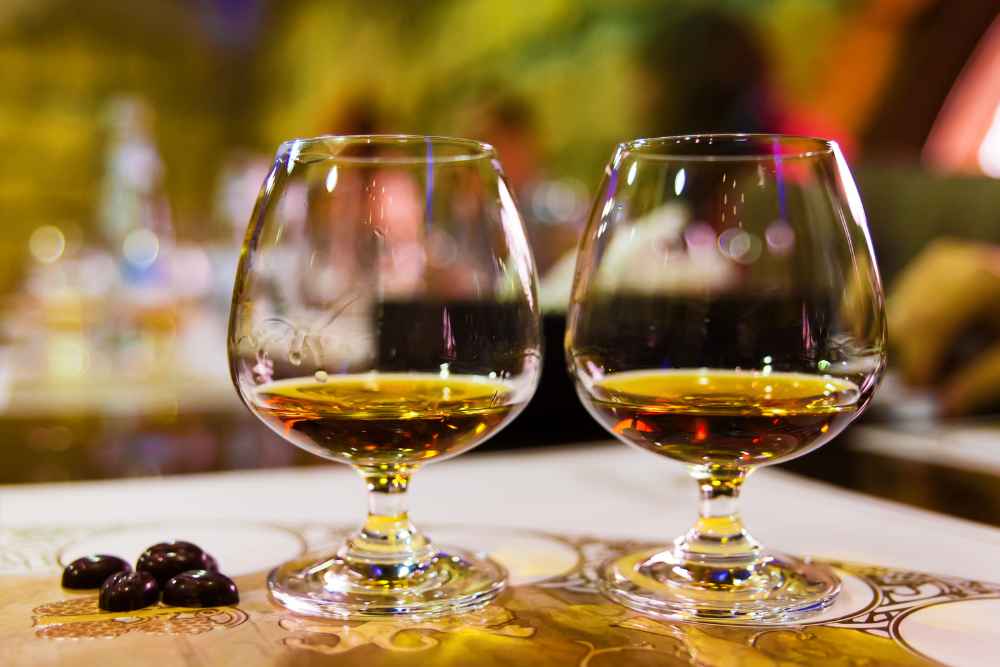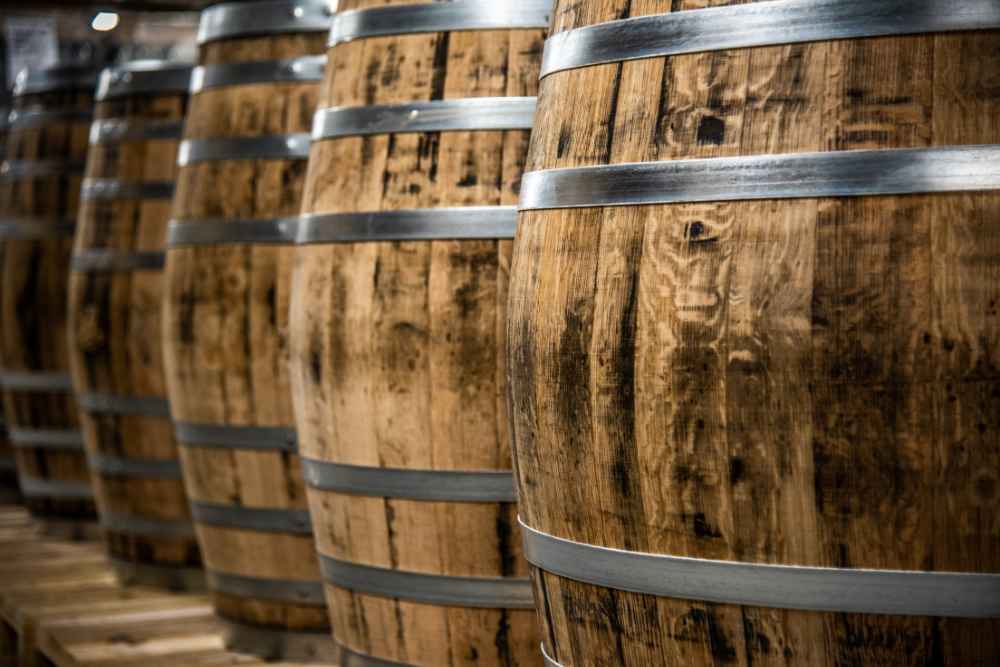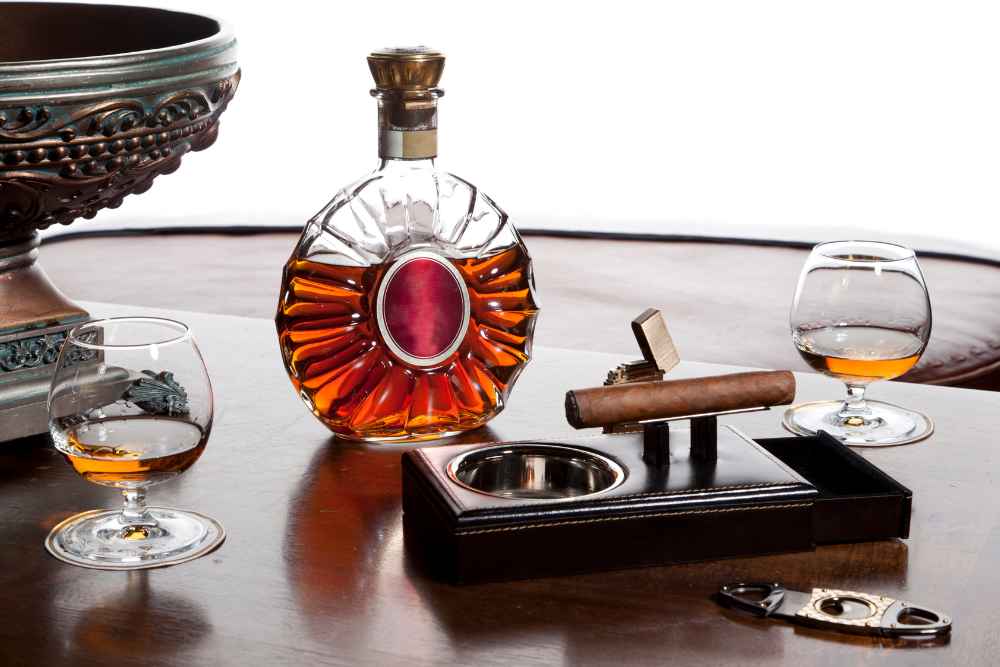This page may contain affiliate links. Please see our Disclaimer for more information. Always drink responsibly and adhere to your local legal drinking age.
Are you ready to learn about one of the world’s oldest and most beloved distilled spirits? Cognac is a classic spirit with a rich history, and it has captured the hearts (and palates) of connoisseurs worldwide.
From French royalty to Hollywood stars, everyone seems to have an affinity for this luxurious spirit—but what exactly is it? Whether you’re an experienced taster or just dipping your toes into the Wonderful World of Cognac, this guide will provide all the details.
So get ready to take your knowledge of Cognac to a new level. This article covers everything from its origins and production process to the different types and how best to drink it. After reading, you can confidently answer, “What is Cognac?”
What Is Cognac?
Cognac is a type of brandy that can only be produced in a few designated areas of France and is made from grapes grown in the region. Cognac’s name is taken from the French town of Cognac, known as the world capital of the drink. It’s made by distilling white wine twice and then aging it in oak barrels. The longer it’s aged, the more complex and smooth its flavor profile becomes.
Regarding flavor, cognac can range from sweet and fruity to dry and spicy, depending on how long it is left to age. You’ll often find notes of ripe fruits like apples, pears, peaches, apricot, plums, aromas and flavors of nuts, spices like vanilla and cinnamon, and even some smokiness. Its ABV (alcohol-by-volume) content usually ranges between 40-60%, making it slightly stronger than your average spirit.
What Does Cognac Taste Like?

Cognac is an intensely flavored, aromatic drink, usually made with a blend of white grapes. It has a distinct, sweet, fruity taste with warm spice and oak notes. Many people describe cognac as having vanilla, tobacco, spices, and even licorice aromas. These flavors are derived from the production method of double distillation, which also concentrates the alcohol level in cognac to around 40 percent ABV.
The flavor profile of cognac varies depending on the aging time and type of cask used during maturation. Typically, longer-aged cognacs will have more pronounced flavor notes like ripe fruit or caramel sweetness. The older a Cognac is, its flavor will be more complex due to greater contact with the oak barrels in which it’s aged.
Where Does Cognac Come From?
As a distilled alcoholic drink, cognac comes from the Cognac region of France. By French law, all cognacs must be produced and bottled in this region; other drinks labeled ‘cognac’ don’t qualify. The area is also designated as an Appellation d’origine controlee (AOC) by the French government, guaranteeing its quality and origin. The AOC is divided into six regions called crus, which the different producers operate out of.
The production process for cognac is a lengthy one that involves the following:
- Growing grapes: Since the majority of the flavor comes from the type of grape used, it must be grown in a vineyard in a Charente region, including the Grande Champagne, Petite Champagne, Borderies, and Fins Bois areas.
- Distillation: The grapes are then put through double distillation to create eau-de-vie (water of life).
- Aging: Eau-de-vie is aged in oak barrels for 2 to 50 years to develop its unique and complex flavor profile before being bottled and sold as cognac.
This lengthy process, coupled with strict requirements on where the ingredients can come from, means that only a few brands can produce high-quality cognacs — so make sure you’re getting something legit!
How is Cognac Made?
If you’re curious about how cognac is made, it’s actually quite a process! It starts with a special grape called Ugni Blanc, Folle Blanche, and Colombard, grown near Cognac in France. The grapes are harvested and then pressed to extract their juice. This juice is fermented with yeast, which turns the sugars into alcohol and carbon dioxide.
Next comes the part that puts cognac head and shoulders above other liquors: double distillation. This separates the ‘heads’ (which produce more flavourful aromas) from the ‘tails’ (which produce more bitter flavors). The heads are collected to make cognac, while the tails are removed entirely.
The resulting liquid is then aged in casks for at least two years, giving it its distinctive golden color. During this time, it is exposed to the terroir, a combination of environmental factors such as climate, temperature, and soil composition that give each variety of cognac its unique flavor profile.
The last step is blending, where different eaux-de-vie are combined to create specific flavor profiles – unique to cognac production! After this process can be bottled – voilà! A classic bottle of cognac awaits your glass!
How Long is Cognac Aged?

Aged to perfection is the perfect way to describe cognac. Cognac is aged for a minimum age of two and a half years but can last for many decades, depending on its blend. In particular, VS Cognac must be aged in French oak barrels for at least 2 years, VSOP for 4 years, and XO for at least 6 years.
It’s no wonder that cognac aging had existed since the 1800s when winemakers wanted to eliminate their surplus wines and make them into spirits. Over time, the process of distillation and aging was refined, with Maison (brands) determining the exact age of each individual barrel and blending them together to create cognacs that embody their house style.
The type of wood used is also crucial in the production process. Maisons’ most popular types are French oak barrels, which provide rich oaky notes typical in a good cognac. The size of the barrel also affects the flavor—smaller casks allow more interaction between the alcohol and wood, increasing flavor intensity.
No matter how long it is aged, one thing is certain: a good cognac will only get better over time, like fine wine!
Different Types of Cognac
Now that you’ve got the basics of cognac down, it’s time to dive into the different types of cognac on offer. There are three main classifications of cognac based on taste and age as determined by the Bureau National Interprofessionnel du Cognac (BNIC):
- V.S. (Very Special): Very Special cognac is aged for at least two years in oak barrels, giving it a light and fruity flavor. This type of cognac is the youngest and most affordable option out there.
- V.S.O.P (Very Superior Old Pale): This type of cognac is aged for at least four years in oak barrels, making it mellower and more complex than V.S. Cognacs.
- X.O (Extra Old): This variety is aged for at least six years. XO Cognac has a complex flavor profile with woody or nutty tones and hints of dried fruit and spices.
It’s also worth noting that a higher-priced cognac isn’t necessarily better than one aged for less time—it all comes down to your preferences regarding taste, texture, complexity, and finish!
Why Is Cognac So Expensive?

You might be wondering why Cognac, of all things, is so expensive. In short, the answer boils down to quality and craftsmanship. The production of Cognac is a lengthy process that involves numerous stages, from harvesting and pressing the grapes to fermentation and distillation.
Quality Ingredients
Cognac is made from high-quality ingredients, including Ugni Blanc grapes from the fertile soils of the cognac region in France. During the double copper pot still distillation process, craftspeople must carefully check the temperature during the distillation process to ensure that only the best liquid is collected.
Aging Process
The resulting liquid must be aged for two years in French Limousin or Troncais oak barrels before it can even be called Cognac. During this aging process, it gains flavor complexity as it interacts with the wood of its barrels. After two years, it’s blended with other Cognacs of different ages to create something special — and expensive!
So when you reach for a bottle next time, you know why it costs what it does! A smooth drink crafted by experienced hands over an extensive period of time is worth every penny.
Tips to Enjoying Cognac
Now that you know more about cognac, here are some tips on how to make the most out of your experience:
Start with a lower-end cognac
Don’t be intimidated by the vast array of exquisite cognacs available. Start off slow—opt for a VS or VSOP instead of jumping right into an XO. This way, you can get familiar with the taste and discover what you like in cognac before investing in pricier bottles.
Serve at the right temperature
The perfect temperature to enjoy your cognac should be 18-21°C (64-70°F). If it’s too cold, you won’t enjoy it in full complexity; if it’s too warm, the aromas and flavors will become less intense.
Use a snifter glass
This iconic glass resembles a wine glass with an extra-wide bowl and narrow stem. The wider surface area lets the aromas escape, allowing for a more flavorful tasting experience.
Offer accompaniments
Traditionally, cognac is served after dinner with some sweet accompaniment. Think candied fruits, macarons, and even chocolates! Offering these items helps to bring out the full flavor of your favorite XO or VSOP cognac.
Best Ways to Drink Cognac
You might be wondering what the best way to drink cognac is. Well, first of all: it’s up to you! Feel free to experiment with the drink until you find the perfect way. But if you’d like some guidance, here are a few ideas:
Neat
Drinking it neat is one of the most popular ways to enjoy cognac. Pour an ounce or two into a nice snifter and let it sit for about 20 minutes at room temperature before taking a sip. This will ensure that all the aromas and flavors are released correctly and you get the whole experience from your cognac.
On The Rocks
If you want a cooler, longer-lasting cognac experience, try adding a few ice cubes or crushed ice and enjoy an invigorating drink that will last longer than just drinking it neat—perfect for hot weather!
In A Cocktail
Cognac can also be enjoyed as part of a cocktail or mixed with other liquids such as fruit juice or soda. Try making yourself something like an “old-fashioned” or an “Americano”—the endless possibilities!
Delicious Cognac Cocktails

Now that you’ve read this guide and understand what cognac is, why not try making some delicious cocktails with it? Cognac is the perfect addition to all sorts of drinks, bringing out sweet and smoky notes in your cocktails. Here are a few of our favorites.
The Sidecar
The sidecar is a classic cognac-based cocktail you can enjoy any time of year. It pairs tart lemon juice with sweet triple sec, adding cognac for extra flavor. Shake everything up with ice and strain it into a chilled glass for a light, refreshing beverage.
The French 75
This traditional French cocktail pairs gin or vodka with sparkling wine, creating a tart, sweet, and bubbly drink. Add just a dash of cognac for an extra hint of spice in this timeless classic.
The Vieux Carre
This punchy Manhattan variation is perfect for evening gatherings—it combines cognac and rye whiskey with angostura bitters and two types of vermouths to create an unforgettable flavor. Try garnishing this one with orange peel or dark cherries to put the finishing touches on your masterpiece!
Food Pairings With Cognac
Sure, cognac is great for sipping straight, but did you know it pairs exceptionally well with food? That’s right—marrying the right dishes with the right cognac can bring out new flavor profiles and a new level of deliciousness.
Fruity and floral pairings
Cognacs with fruity and floral notes pair best with light dishes with sweetness. Think shellfish, roasted chicken and other poultry, grilled vegetables, or fruit-infused desserts. If your dessert contains alcohol already, try to match the amounts of sweetness in both.
Spicy pairings
Smooth Cognacs with a hint of spice like cinnamon or cardamom pair well with spicy dishes like Asian curries, hearty stews, or even grilled meats like spicy sausage links.
Woodsy pairings
Woodsy Cognacs often have smoky herbal notes that go great with earthy flavors like mushrooms and truffles. To increase their flavor profile, you can also match these earthy flavors with lighter dishes, such as salads containing fruits like apples and pears.
Cognac vs Brandy
If you’re a fan of spirits, you’re probably familiar with brandy. But what’s the difference between cognac and brandy?
Cognac is a specific type of brandy, but let’s explore why they are called different names.
When it comes to distinctions, there are two big ones. First, cognac must be made exclusively in Cognac, France — just like fine champagne must be produced in the Champagne region. Additionally, the base spirit used to make cognac must be distilled twice (brandies can be distilled once or even not at all).
Cognacs have exceptional depth of flavor. When you drink it neat, you’ll notice its sweetness and should detect flavors like toffee, honey, white flowers, and dried fruits. Depending on age, its color can range from clear/pale straw to deep amber hues.
Cognacs also range from VS (very special), VSOP (very superior old pale), and XO (extra old). Generally speaking, these designations indicate how long the cognac has been aged in oak barrels: VS has been aged for at least two years, VSOP for four; and XO for 10 or more years.
Although there are several basic differences between cognacs and brandies — including where they come from and how they’re made — both styles of distilled wine spirits have a lot in common too: colorless when young, a product of a double distillation method, contain 40%-60% alcohol; and notable amounts of natural sugar. But when it comes down to it — if you want the best of the best — look for “cognac” instead of “brandy” on the label.
Best Cognac Brands
Choosing the best cognac brand can be overwhelming, but if you know what you’re looking for, it can be easy to narrow it down. Here are some of the top cognac brands that have been around for centuries, providing flavor and quality since the 17th century.
Hennessy
Hennessy is one of the oldest and most well-known luxury brands, having been around since 1765. It’s also one of the biggest producers in the world and one of the most esteemed cognac houses. They offer various blends at all levels of quality, making it a great option for everyone, from connoisseurs to casual drinkers.
Try this delicious Strawberry Hennessy Cocktail.
Rémy Martin
Established in 1724, Remy Martin has long been recognized as one of the finest cognacs available thanks to its distinctive full-bodied taste and complex flavors. Their bottles feature artwork that pays homage to their origin story but also stands out as modern art pieces in their own right—perfect for adding a touch of style to any collection.
Courvoisier
When it comes to flavor, Courvoisier is hard to beat. They offer a wide selection ranging from VSOP and XO blends to their luxurious Napoleon blend. Their bottles are also designed with sophistication in mind—the perfect symbol for your personal taste and refinement.
If you’re looking for an affordable option that doesn’t skimp on quality or taste, consider Martell Cognac or Meukow Cognac. Both brands offer excellent blends with inviting aromas that don’t overpower your palate. Plus, they come at an attractive price point.
FAQ
We know you have questions about cognac, so let’s look at some of the most common FAQs about this noble liquor.
What is cognac made from?
Cognac is a brandy made from distilling white wine grapes grown only in a designated area around Cognac in France. The resulting distillate is aged for at least two years in French oak barrels and must contain at least 40 percent alcohol.
What is the difference between cognac and Armagnac?
Armagnac is another type of brandy, but it’s produced in smaller quantities and aged differently than cognac. Armagnac is distilled once while Cognacs are distilled twice; Armagnacs are aged in single-use casks while Cognacs are aged in larger oak barrels; and, finally, Armagnacs usually have more intense smoky flavors than Cognacs.
Is Cognac strong?
Yes! Typically, cognacs are around 40 percent ABV (80 proof). Although Brandy has a slightly lower ABV (around 36-38 percent), it still packs a punch. We suggest sipping it slowly to enjoy its complexity and flavor nuances!
Cognac Wrapup
Cognac is a type of brandy produced exclusively in France’s Cognac region. The name “cognac” is protected by law, meaning that only brandy made in this specific region and using specific grape varieties can legally be called cognac.
The spirit is made from two grape varieties, Ugni Blanc and Folle Blanche, and is distilled in copper stills before being aged in French Limousin oak barrels. The cellar master plays an important role in cognac production, as they blend different ages and grape varieties to create a consistent flavor profile. The youngest cognac is aged for at least two years, and the alcohol content must be between 40% and 60%.
The Cognac region is divided into six crus, or growing regions, with Grande Champagne and Petite Champagne considered the best areas for producing cognac. Age statements on cognac bottles indicate the youngest eau-de-vie used in the blend, with some old cognacs aged over 50.
Brandy is Cognac, but unlike other brandies, such as those made from grain, cognac cannot be made anywhere else. The strict regulations and high standards for cognac production result in highly sought-after cases, with some of the most well-known brands, including Hennessy, Remy Martin, and Martell. The best way to describe cognac is as a luxurious and complex spirit that is best savored slowly and enjoyed in moderation.
Conclusion
We can say that Cognac is an unmistakably decadent luxury and a favorite of many. Whether you’re drinking the most expensive bottle of the highest quality or simply appreciating cognac’s influence in cocktail recipes, it’s always a pleasure.
Cognac is inherently complex and multi-faceted, from its production process to flavor profiles. As you explore the world of cognac, don’t forget to take it all in. The complexity of the spirit gives it an air of sophistication, and we’re sure you’ll enjoy every sip as you discover its depths.
If you’re seeking a smooth, luxurious spirit, there’s no better option than Cognac. It’s a long-standing classic and will remain so for many decades.



















